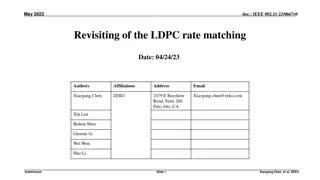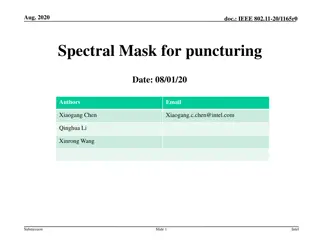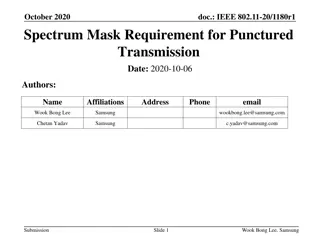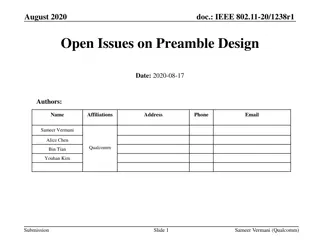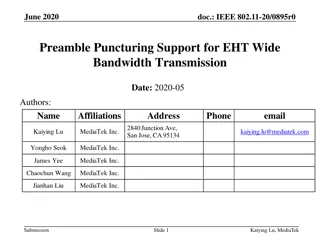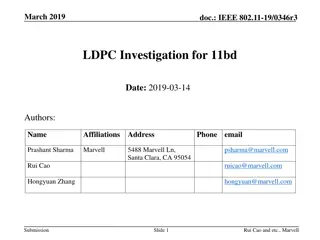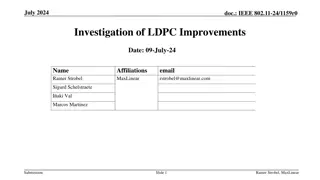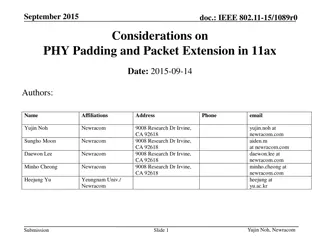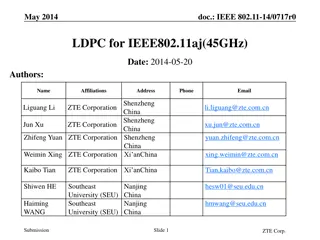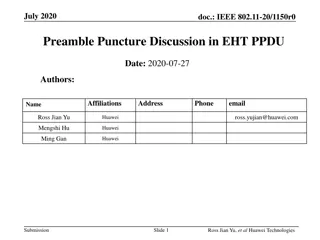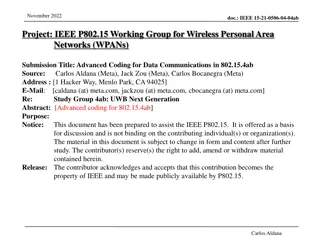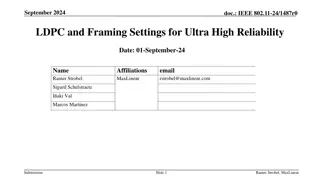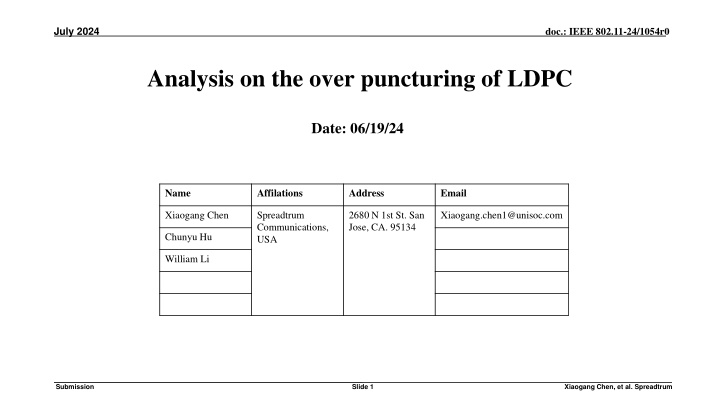
Analysis on IEEE 802.11-24 LDPC Puncturing Issue
Explore the challenges of over-puncturing in LDPC codes within the IEEE 802.11-24 standard. The analysis delves into thresholds, symbol additions, and potential solutions to mitigate the impact of over-puncturing on signal quality and performance.
Download Presentation

Please find below an Image/Link to download the presentation.
The content on the website is provided AS IS for your information and personal use only. It may not be sold, licensed, or shared on other websites without obtaining consent from the author. If you encounter any issues during the download, it is possible that the publisher has removed the file from their server.
You are allowed to download the files provided on this website for personal or commercial use, subject to the condition that they are used lawfully. All files are the property of their respective owners.
The content on the website is provided AS IS for your information and personal use only. It may not be sold, licensed, or shared on other websites without obtaining consent from the author.
E N D
Presentation Transcript
July 2024 doc.: IEEE 802.11-24/1054r0 Analysis on the over puncturing of LDPC Date: 06/19/24 Name Affilations Address Email Xiaogang Chen Spreadtrum Communications, USA 2680 N 1st St. San Jose, CA. 95134 Xiaogang.chen1@unisoc.com Chunyu Hu William Li Submission Slide 1 Xiaogang Chen, et al. Spreadtrum
July 2024 doc.: IEEE 802.11-24/1054r0 Problem statement The criteria below are used to avoid over-puncturing in LDPC. 1st threshold: the number of punctured parities per CW is less than 30% of the total parity bits per CW; 2ndthreshold: the number of punctured parities per CW is less than 10% of the total parity bits per CW if the number of shortening bits is less than a code rate dependent threshold; Extra symbol (n_SD_short) is added if either criteria above is triggered. Submission Slide 2 Xiaogang Chen, et al. Spreadtrum
July 2024 doc.: IEEE 802.11-24/1054r0 Problem analysis (1/3) Before 11ax, a whole symbol is added if over puncturing is triggered. Nsd = 52/108/234/468 for 20/40/80/160MHz. The current Nsd_short is shown below: All the small RU/MRU has Nsd_short much less than 52 (minimum value in 11ac/n) Submission Slide 3 Xiaogang Chen, et al. Spreadtrum
July 2024 doc.: IEEE 802.11-24/1054r0 Problem analysis (2/3) If using the two threshold in page 2 as golden rule , then all the small RU/MRU will be risky on over puncturing especially if lower MCS is used. The extra symbol is only added one time and no further checking is done. Excel sheet below lists the combinations with over puncturing for small RU/MRU in 1SS. Submission Slide 4 Xiaogang Chen, et al. Spreadtrum
July 2024 doc.: IEEE 802.11-24/1054r0 Problem analysis (3/3) Puncturing introduces 0.5~2dB loss depends on puncturing ratio (10%-30%) [1] Blk: 0% Punc; Red: 10% Punc; Blue: 20% Punc; Green: 30% Punc. Note: sims is for 1 CW (1944) in ChDNLoS 4x2x1. Shortening can compensate the performance loss. Submission Slide 5 Xiaogang Chen, et al. Spreadtrum
July 2024 doc.: IEEE 802.11-24/1054r0 Discussions on the solutions (1/2) Opt.1: Continue use the two threshold as golden rule ; Adjust the N_sd_short for small RU/MRU (26/52/106/106+26/52+26); E.g. for small RU/MRU, always add a full symbol instead of quarter symbol. Allow multiple extra symbols. Change the 1 bits to 2/3 bits to indicate multiple extra symbols. Opt.1 is Simple change in spec and implementation; Significantly reduce or eliminate the over puncturing. Opt.2 re-evaluate the two threshold and come up with new rules to address over puncturing. Extensive simulation is required. Submission Slide 6 Xiaogang Chen, et al. Spreadtrum
July 2024 doc.: IEEE 802.11-24/1054r0 Discussions on the solutions (2/2) With Opt.1, The changes are The two updates below will be simplified This simplified version just need to be done multiple times if more extra symbol is allowed. PE Disambiguity need one extra bit. Submission Slide 7 Xiaogang Chen, et al. Spreadtrum
July 2024 doc.: IEEE 802.11-24/1054r0 Summary Propose to reduce or remove the combination of over puncturing in small RU/MRU for LDPC. Opt.1 is preferable. Submission Slide 8 Xiaogang Chen, et al. Spreadtrum
July 2024 doc.: IEEE 802.11-24/1054r0 SP Do you agree to reduce (or remove) the combinations that introduce over puncturing in LDPC for small RU/MRU? The solution to reduce these combination is TBD. Candidate solution is opt.1 in page 6. Submission Slide 9 Xiaogang Chen, et al. Spreadtrum
July 2024 doc.: IEEE 802.11-24/1054r0 Reference [1] 11-23-0667-01-0uhr-revisiting-of-the-rate-matching-for-ldpc Submission Slide 10 Xiaogang Chen, et al. Spreadtrum

